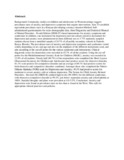| dc.contributor.author | Ndetei David M. | |
| dc.contributor.author | Khasakhala, Lincoln | |
| dc.contributor.author | Nyabola, Lambert | |
| dc.contributor.author | Ongecha-Owuor, Francisca | |
| dc.contributor.author | Seedat, Soraya | |
| dc.contributor.author | Mutiso, Victoria | |
| dc.contributor.author | Kokonya, Donald | |
| dc.contributor.author | Odhiambo, Gideon | |
| dc.date.accessioned | 2013-02-25T11:58:22Z | |
| dc.date.issued | 2008 | |
| dc.identifier.citation | Journal of Child & Adolescent Mental Health, 20: 1, 33-51 | en |
| dc.identifier.uri | http://erepository.uonbi.ac.ke:8080/xmlui/handle/123456789/11172 | |
| dc.description | The prevalence of anxiety and depression symptoms and syndromes in Kenyan children and adolescents | en |
| dc.description.abstract | Background: Community studies on children and adolescents in Western settings suggest prevalence rates of anxiety and depressive symptoms that require intervention.
Aim: To establish equivalent prevalence rates in a Kenyan (developing country) situation
Method: Self-administered questionnaires for socio-demographic data, three Diagnostic and Statistical Manual of Mental Disorders - Fourth Edition (DSM-IV)-based instruments for anxiety symptoms and syndromes in children, one instrument for depression and one culture sensitive instrument for depression and anxiety were administered in three different sets to 3 775 randomly sampled students drawn from a stratified sample of 34.7% of all public secondary schools in Nairobi, Kenya.
Results: The prevalence rates of anxiety and depression symptoms and syndromes varied widely depending on sex and age and also on the emphasis of the different instruments used, and also according to the cut-off points for the various syndromes and instruments. Clinical diagnostic scores for depression were recorded in 43.7% of all the students. Using the cut-off points for the Multidimensional Anxiety Scale for Children (MASC), anxiety was recorded in 12.9% of all students. Nearly half (40.7%) of the respondents who completed the Short Leyton Obsessional Inventory for Children and Adolescents had positive scores for obsessive disorder, 81.1% were positive for compulsive disorder and an average of 69.1% had positive scores for both obsessive and compulsive disorders combined. Amongst those who completed the Ndetei-Othieno-Kathuku (NOK) scale for Depression and Anxiety, 49.3% had positive scores for moderate to severe anxiety with or without depression. The Screen for Child Anxiety Related Disorders - Revised (SCARED-R) yielded high levels (50-100%) for the different syndromes, with obsessive-compulsive disorder at 99.3%, just below separation anxiety and school phobia at 100%. Suicidal thoughts and plans were prevalent at 4.9-5.5%.
Conclusion: Anxiety and depression were found at prevalence rates no less than is found in the West. This calls for appropriate clinical practices and policies. | en |
| dc.language.iso | en | en |
| dc.publisher | Routledge | en |
| dc.title | The prevalence of anxiety and depression symptoms and syndromes in Kenyan children and adolescents | en |
| dc.type | Book | en |
| local.publisher | Department of Psychiatry, University of Nairobi | en |
| local.publisher | Africa Mental Health Foundation, | en |
| local.publisher | Department of Psychiatry and MRC Unit on Anxiety and Stress Disorders, University of Stellenbosch | en |

